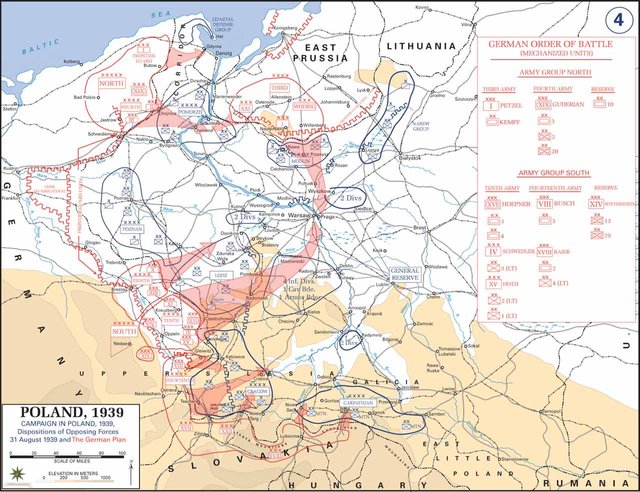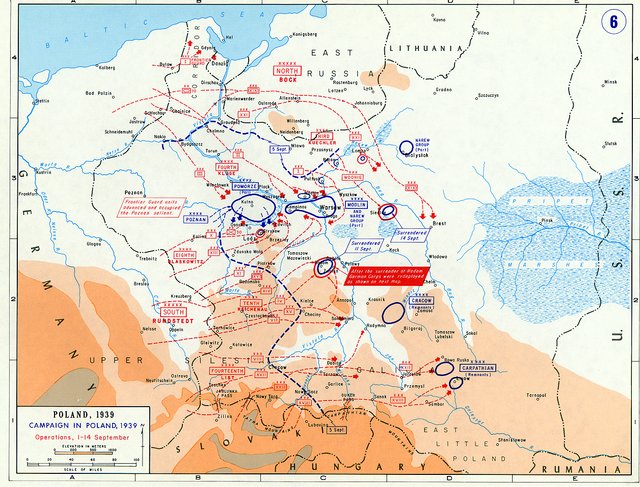Blitzkrieg in Action: The German Invasion of Poland, 1939
The post I wrote yesterday about the defining elements of Blitzkrieg got me re-reading some older histories of the Second World War, and I thought I'd continue today by noting the early successes of this tactic. If you recall (or if you read yesterday's post), I argued that a survey of some classic literature suggested the defining features of Blitzkrieg were radios, which allowed close communication and coordination between armored spearheads and ground-attack aircraft. With this close coordination, it was possible to attack and following up attacks with greater speed than ever before, and to focus on penetrating enemy lines with these armored spearheads. Once penetration was achieved, the armored units in the vanguard could drive deep into enemy territory, cutting off supply lines and disrupting communication, encircling slower-moving bodies of enemy troops, and striking at supply and command centers. Today, I'll add John Keegan's further argument, from his The Second World War, that "Blitzkrieg depended for its effect on the co-operation or, at the very least, the acquiescence of the enemy" (407). This came in two forms: first, Keegan notes that an opponent facing *Blitzkrieg* had to be lacking in the ability to stop armored attacks, and second, that it had to essentially allow itself to be encircled. Just how these particular scenarios played out was slightly different in Poland in 1939, Western Europe in 1940, Russia in 1941, and, for good measure, again in both Russia and France in 1944, but with the combatants reversed so that it was the Wehrmacht that was effectively victimized by the tactic it had first implemented. I'll begin with a discussion of Poland, and then progress through other examples in later posts.

The positions of the various forces in Germany and Poland at the start of the German invasion in September, 1939. Note the heavy concentration of Polish forces in western Poland, where they were vulnerable to envelopment by German armored thrusts.
B. H. Liddell Hart argues, in his History of the Second World War, that Polish forces were deployed much too close to the German border to effectively resist a German invasion. Indeed, with the awkward shape of the country after the Versailles Treaty in 1919, all of western Poland was arguably a giant salient sticking into Germany's waiting grasp. The Poles deployed so many of their forces on the western frontier, however, because they believed they needed to protect the economically vital Silesian coalfields and to maintain the territorial integrity of their relatively young national state. For the same reason, they also deployed many forces in the "Polish Corridor," the strip of territory featuring the port of Danzig (Gdansk) and separating Germany "proper" from East Prussia. Their final large body of troops they held in reserve, in anticipation of launching a counter attack once the expected German invasion came. This reflected a broader faith in counter attack that also led the Polish military commanders to neglect defensive fortifications closer to the frontier; they apparently believed that, despite an army that operated almost wholly on foot, they would be able to fight a war of maneuver against the German invaders (27-30). As Liddell Hart explained, "This grouping [of Polish forces] embodied the offensive spirit, but its aim of intervening with a counterattack did not correspond to the Polish Army's limited capacity for maneuver, even if this had not been cramped by German air attack on the rail and road routes of movement," as it was (28). Further, the Polish army possessed few tanks; against the 3000 German armored vehicles, it could field fewer than 1000 of its own, and fewer than 150 of them were "modern" tanks capable of fighting and destroying opposing tanks. Its infantry units possessed anti-tank rifles that could be effective against light German tanks, but it had relatively few of them and precious few heavy anti-tank guns. Thus, at both tactical and strategic levels, the Poles were unprepared for the German Blitzkrieg, to the point that Keegan might argue that they acquiesced in it.
When the invasion came on the morning of September 1, 1939, its initial speed and violence, and the coordination of air and ground attack made possible by radio was fully in evidence. Not only did it smash through the Polish lines, and destroy the bulk of their air force within 24 hours, it also wrought havoc on their railways (noted above)--and an unmechanized army needs railways to move any faster than walking speed. Polish forces did try to counter attack, but their efforts were stymied by the rapid advance of the Germans, and their paucity of armor and anti-tank weapons. Liddell Hart explained that "The Poles forward concentration in general forfeited their chance of fighting a series of delaying actions, since their foot-marching army was unable to get back to the positions in the rear, and many them, before they overrun by the invader's mechanized columns" (28). By the time Britain and France entered the war on September 3, German forces had already cut the base of the Corridor, isolating Polish troops there; other thrusts proceeded even faster, with one unit reaching the outskirts of Warsaw just eight days into the conflict, covering 140 miles in that time. Unable to stop the points of German armored spearheads due to their lack of armor and anti-tank weapons, unable to maneuver quickly enough to counter them, and pushed far too far forward, the main Polish forces were soon outflanked, cut off from one another, and effectively paralyzed, unable to coordinate their efforts, and barely able to slow the invasion, never mind stop it. The one real alarm that faced the Germans was when, after significant numbers of Polish troops made it across the Vistula River, the German thrusts re-calibrated their axes of advance, aiming east of Warsaw so as to encircle not only the escaping Polish troops but also the capital. This provided a momentary opening, and the Polish Poznan Army managed to execute a successful counter attack on the German Eighth and Tenth Armies, inflicting heavy casualties on the surprised 30th Division. However, with their superior mobility, German forces won the ensuing struggle, surrounding over 100,000 Polish troops (Keegan, 45-46). Ultimately, the bulk of Polish forces originally stationed west of the Vistula were destroyed; as Liddell Hart put it, "Although the Poles fought fiercely, with a bravery that greatly impressed their opponents, only a small proportion ultimately managed to break out [from the German pincer movement surrounding them], by night, and join the garrison of Warsaw (30). In the end, then, the Poles--for all their valor--had no antidote to German armor at a tactical level, for they lacked tanks and anti-tank weapons. At a strategic level, they were poorly deployed, and unable to maneuver. As a result, the German campaign in September of 1939 was not only the demonstration of mobile, combined arms, it was also the event that provided the word: Blitzkrieg.

After the initial penetrations, Polish forces were rapidly surrounded and isolated, cut off from supplies and each other.
Sources:
Keegan, John. The Second World War. New York: Penguin, 1989.
Liddell Hart, B. H. History of the Second World War. New York: Capricorn, 1971.
Congratulations @agentdcf! You have completed some achievement on Steemit and have been rewarded with new badge(s) :
Click on any badge to view your own Board of Honnor on SteemitBoard.
For more information about SteemitBoard, click here
If you no longer want to receive notifications, reply to this comment with the word
STOPBy upvoting this notification, you can help all Steemit users. Learn how here!
Congratulations @agentdcf! You have completed some achievement on Steemit and have been rewarded with new badge(s) :
Click on any badge to view your own Board of Honnor on SteemitBoard.
For more information about SteemitBoard, click here
If you no longer want to receive notifications, reply to this comment with the word
STOPBy upvoting this notification, you can help all Steemit users. Learn how here!
Congratulations @agentdcf! You have completed some achievement on Steemit and have been rewarded with new badge(s) :
Click on any badge to view your own Board of Honnor on SteemitBoard.
For more information about SteemitBoard, click here
If you no longer want to receive notifications, reply to this comment with the word
STOPBy upvoting this notification, you can help all Steemit users. Learn how here!
Congratulations @agentdcf! You received a personal award!
You can view your badges on your Steem Board and compare to others on the Steem Ranking
Vote for @Steemitboard as a witness to get one more award and increased upvotes!